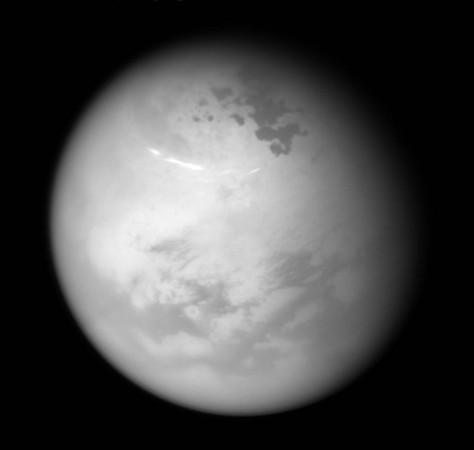A study has found that the lakes and seas of Saturn's largest moon Titan, comprising liquid hydrocarbon are very calm. These findings point toward the future missions of Titan being smooth for the landing of spacecraft.
Also Read: Mars-sized planet: Have researchers discovered a 10th planet in our Solar System?

Three largest bodies of fluid on Titan which are present in the northern hemisphere are found to have minute waves. These waves measure around a centimetre in height and 20 centimetres in length. The seas and lakes of Titan are also found to consist of very cold methane and ethane which are placid enough for spacecraft to land on its surface.
The lead author of this study was Cyril Grima, who said: "There is a lot of interest in one day sending probes to the lakes, and when that is done, you want to have a safe landing, and you do not want a lot of wind. Our study shows that because the waves aren't very high, the winds are likely low," Gizmodo reported.
The data collected by NASA's Cassini spacecraft was analysed by Grima and the cohort of researchers to understand the three lakes of Titan better.
The three lakes of Titan -- Ligeia Mare, Kraken Mare and Punga Mare -- are made up of liquid hydrocarbon.

Here are some interesting things to know about the lakes and seas of Titan:
1. Fluid-filled bodies comprising of ethane and methane exist on Titan, the large ones are known as maria (seas) and the small ones as lacūs (lakes).
2. The biggest body of liquid on the surface of Titan is the Kraken Mare, it is as large as the Caspian Sea and was discovered by the Cassini probe in 2008.
3. The second largest body of fluid present on Titan's surface is Ligeia Mare, which is found to be bigger than Lake Superior, the largest lake in North America. It is believed to have an oil reserve which is 50 times greater than that of the Caspian Sea. It is present in the north polar region of Titan.
4. The third biggest body of liquid present on the ringed planet's largest moon Titan is Punga Mare, which is present in the north polar region of the natural satellite.
5.Though there are no plans to send any mission to Titan anytime soon, the astronomers are working on boats and submarines to explore the mysterious seas and lakes of the moon.












!['Had denied Housefull franchise as they wanted me to wear a bikini': Tia Bajpai on turning down bold scripts [Exclusive]](https://data1.ibtimes.co.in/en/full/806605/had-denied-housefull-franchise-they-wanted-me-wear-bikini-tia-bajpai-turning-down-bold.png?w=220&h=138)
![Nayanthara and Dhanush ignore each other as they attend wedding amid feud over Nayanthara's Netflix documentary row [Watch]](https://data1.ibtimes.co.in/en/full/806599/nayanthara-dhanush-ignore-each-other-they-attend-wedding-amid-feud-over-nayantharas-netflix.jpg?w=220&h=138)



